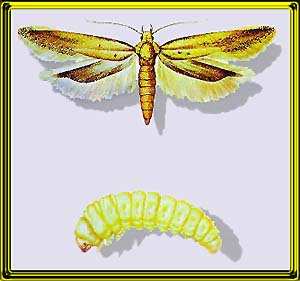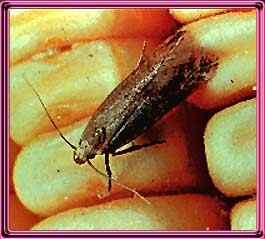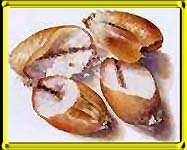
Sitotroga
cerealella
(Angoumois Moth)
(Angoumois Moth)
The Angoumois grain moth is second only to the rice and granary weevils in its importance as a pest of stored grain in the United States. It attacks grains maturing in the field as well as in storage. Infested grain in storage has a sickening taste and smell that make it unpalatable. Only whole grain is attacked, so other grain products are safe (Linsley and Michelbacher, 1943). Angoumois grain moths can infest the ripening maize on the fields and are thus carried into the storerooms. The larva lives inside the grain kernel and is therefore difficult to spot (so-called "inner infestation").Besides grain they also infest pulses and seeds.
Larvae inside wheat kernel
Description: The adults are small, buff to grayish or yellowish-brown moths, with a wingspread of 13 to 17 mm. The size of the adult depends on how much food the larva has consumed. The hindwings narrow down to a point apically, and are heavily margined with long hairs.

Adult moth on maize
Life Cycle: The males and females come together using identified pheromones (specific aromatic attractant substances). Each female lays an average of about 40 tiny white eggs on or near the grain, and in 4 to 8 days these hatch into minute, white larvae that bore into the kernels of barley, rye, corn, oats and wheat. The larvae are pale yellowish when mature, with a yellowish-brown head, and are about 5 mm long when full grown. They have poorly developed abdominal prolegs. The larva passes through 3 instars in about 3 weeks, but may hibernate before changing to a reddish-brown pupa in the spring. Pupation takes place in a silken cocoon in the feeding cavity in the kernel. There are 2 to 4 generations a year. Ideal temperature for development is 30-32°C at a relative humidity of 75%.

Type of damage to wheat
Treatment:
The only succesful way to treat this problem is to fumigate, this is because the problem is hidden in the form of the larvae until the population of adults gets to such a point as it becomes obvious. Fumigation will kill the larvae and adults in one go. Another way of controlling the adults is to use pheromone traps, which continue to be developed and refined by various companies around the world.
